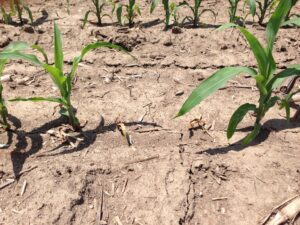This is the second of a 3-part AgVenture series to familiarize you with the common corn seedling diseases you may encounter this spring. Part 1 was a discussion of conditions that promote disease prominence in US fields. Next let’s take a look at the most likely candidates that will attack young corn plants.
Content by Mark Jeschke, Ph.D., Agronomy Manager, Corteva Agriscience
Soil-inhabiting disease organisms that attack corn seeds and seedlings include Pythium, Fusarium, Rhizoctonia, Penicillium, Colletotrichum, Diplodia, and others. Each of these fungal genera includes multiple species capable of infecting corn that can differ in pathogenicity and environmental influences.

These corn plants from Indiana had multiple pathogens at work on them, including pythium, fusarium, and more.
Pythium, a water mold that survives in soil and plant debris, is an otherwise weak pathogen that tends to predominate under very wet soil conditions. This is because high soil moisture levels promote germination of the overwintering oospores. Soil water also provides a medium for the swimming of zoospores, the germinated motile spores that infect the corn root system. Pythium is one of the first groups of fungi to attack corn in the spring, due to the low temperature optimum of some species. Cool soil temperatures of 50-60°F (10-16ºC) favor several Pythium species that are common in northern areas, particularly in early-planted fields, but the various species of Pythium are active over a wide range of temperatures.
Other seedling pathogens like Fusarium and Rhizoctonia do not require extremely wet conditions in order to cause disease. Fusarium is a ubiquitous soil-borne group of fungi that can be found to some degree on the majority of corn plants suffering from seedling diseases. Rhizoctonia is another very prevalent fungal group with a wide range of plant hosts.
When a corn plant succumbs to seedling disease, multiple pathogens are usually involved. Dying seed or seedling tissues below ground are rapidly colonized by a variety of fungi, all of which contribute to the decay, making it difficult to determine the primary pathogen. Consequently, it is useful to think of corn seedling disease as a complex of fungi that must be controlled as a group. Management strategies to reduce the risk of injury from soilborne pathogens are largely the same, regardless of the pathogen involved.
Seed and Plant Symptoms
Soilborne pathogens may attack seeds and seedlings both before and after plant emergence, as well as the roots and mesocotyl of emerging or established plants.
Seeds: In some cases, seeds may rot prior to germination. Affected seeds are often soft, discolored, and overgrown with fungi. Rotted seeds decompose very rapidly and may be difficult to find. Soil adhering tightly to the decomposing seed may help to obscure it.
Pre-emerged seedlings: Oftentimes, the seed germinates but the seedling is killed before it emerges from the soil. The coleoptile and primary roots may be discolored and have a wet, rotted appearance.
Post-emerged seedlings: Seedlings may emerge through the soil surface before developing symptoms. Plants affected at this stage may grow more slowly than surrounding, healthy plants and appear chlorotic (yellow), stunted or wilted. In severe cases, damping off of seedlings may occur. Damping off generally refers to rapid wilting and death of seedlings as soft rot collapses the stem, often at the soil line. Pythium and Fusarium are the most common fungi associated with seed rot and damping off of corn.
Roots and mesocotyl: Discolored, sunken lesions may be evident on the mesocotyl, which eventually becomes soft and water soaked. The root system is usually poorly developed and discolored, and water-soaked roots may slough off. If the primary root system and mesocotyl are severely affected before the nodal or permanent root system has developed, the plants have little chance of survival.
Coming next in Part 3 we will concentrate on steps that can be taken to reduce the severity of corn seedling diseases on your farm.